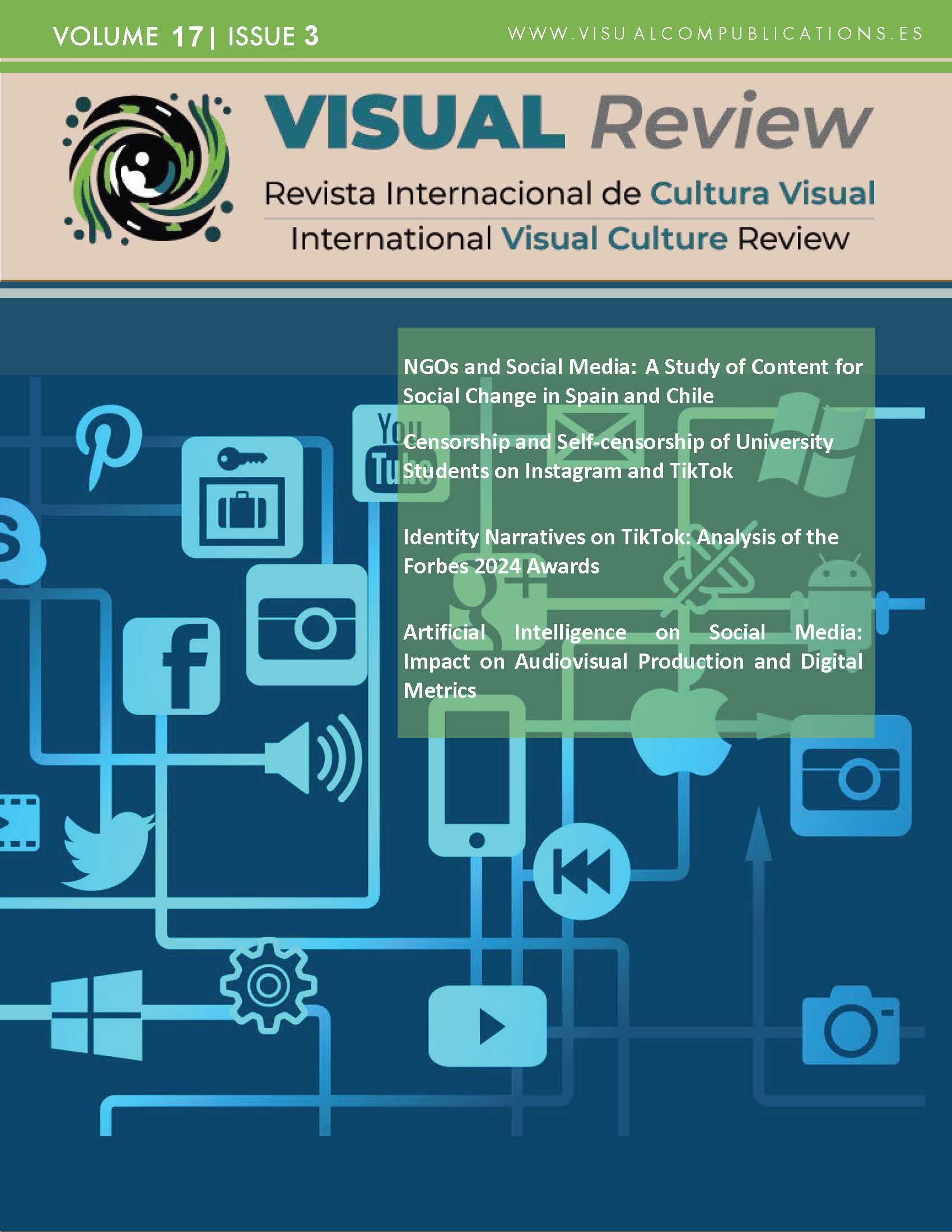Narrativas Identitarias en TikTok
Análisis de los Premios Forbes 2024
DOI:
https://doi.org/10.62161/revvisual.v17.5790Palabras clave:
Redes Sociales, TikTok, Influencers, Comunicación, Identidad, Tendencias, ForbesResumen
La investigación examina la influencia que ejercen los TikTokers destacados en la lista Forbes 2024 en la construcción de identidades individuales y colectivas en el ciberespacio. Mediante una rúbrica creada exprofeso, se persigue comprender cualitativamente las estrategias de autorrepresentación y performatividad de los perfiles nominados (n=34). Los hallazgos revelan cómo estas prácticas moldean discursos, generan tendencias, refuerzan estereotipos y configuran aspiraciones que afectan a las audiencias. Asimismo, las conclusiones enfatizan el papel de los creadores de contenido en la conformación de narrativas digitales, destacando las complejas interacciones entre la influencia individual –e impacto social– y la construcción de marca personal.
Descargas
Estadísticas globales ℹ️
|
519
Visualizaciones
|
421
Descargas
|
|
940
Total
|
|
Citas
Andonopoulos, V. (2021). Authentic, but make it personal: an examination of social media influencer personal authenticity. [Doctoral thesis] The University of New South Wales. Electronic Thesis and Dissertation Repository. https://doi.org/10.26190/unsworks/2339
Arriagada, A., & Bishop, S. (2021). Between commerciality and authenticity: The imaginary of social media influencers in the platform economy. Communication, Culture and Critique, 14(4), 568-586. https://doi.org/10.1093/ccc/tcab050
Arriagada, A., & Ibáñez, F. (2020). “You need at least one picture daily, if not, you’re dead”: content creators and platform evolution in the social media ecology. Social Media + Society, 6(3). https://doi.org/10.1177/2056305120944624
Ayala, T. (2014). Redes sociales, poder y participación ciudadana. Revista Austral de Ciencias Sociales, (26), 23-48.
Baym, N. K. (2015). Personal connections in the digital age. John Wiley & Sons.
Bertoni, S. (2024). Los 10 creadores de contenidos que más cobran del mundo. Forbes. https://forbes.es/listas/528903/10-content-creators-mas-cobran/
Brooks, G., Drenten, J., & Piskorski, M. J. (2021). Influencer celebrification: How social media influencers acquire celebrity capital. Journal of advertising, 50(5), 528-547. https://doi.org/10.1080/00913367.2021.1977737
Butler, J. (1990). Gender Trouble: Feminism and the Subversion of Identity. Routledge.
Butler, J. (1993). Bodies That Matter: On the Discursive Limits of Sex. Routledge.
Castañeda, V. G. G. (2019). Estética del sujeto hipermediatizado: Edición, estilización y curaduría del yo en la red. ASRI: Arte y sociedad. Revista de investigación, (17), 12-24.
Chaffey, D. (2023). Global Social Media Statistic Research Summary 2023 [Blog]. Smart Insights. https://bit.ly/4h34ktx
Cheung, M. L., Leung, W. K., Aw, E. C. X., & Koay, K. Y. (2022). “I follow what you post!”: the role of social media influencers’ content characteristics in consumers' online brand-related activities (COBRAs). Journal of Retailing and Consumer Services, 66, 102940. https://doi.org/10.1016/j.jretconser.2022.102940
Cotter, K. (2019). Playing the visibility game: How digital influencers and algorithms negotiate influence on Instagram. New media & society, 21(4), 895-913. https://doi.org/10.1177/1461444818815684
Dorofeeva, M., & Öze, N. (2023). Instagram’s Influence on Self-representation of Young Users. Akdeniz Üniversitesi İletişim Fakültesi Dergisi, (43), 1-18. https://doi.org/10.31123/akil.1352954
Dueñas, P. P. M., & Simancas-González, E. (2024). Análisis sobre la eficacia del influencer marketing en el mundo de la moda. European Public & Social Innovation Review, 9, 1-15. https://doi.org/10.31637/epsir-2024-340
Elorriaga Illera, A., & Monge Benito, S. (2018). La profesionalización de los youtubers: el caso de Verdeliss y las marcas. Revista latina de comunicación social, 73, 37-54. https://doi.org/10.4185/RLCS-2018-1244
Enke, N., & Borchers, N. S. (2021). Social media influencers in strategic communication: A conceptual framework for strategic social media influencer communication. In N. S. Borchers (Ed.), Social media influencers in strategic communication (pp. 7-23). Routledge. https://doi.org/10.4324/9781003181286
Faltesek, D., Graalum, E., Breving, B., Knudsen, E., Lucas, J., Young, S., & Varas Zambrano, F. E. (2023). TikTok as television. Social Media+ Society, 9(3), 1-13. https://doi.org/10.1177/20563051231194576
Felix, A., Bernanda, D. Y., Rembulan, G. D., Giovanno, N., & Muti, R. N. (2024, August). Micro influencers enhancing brand visibility and audience engagement on tiktok digital platform. In 2024 3rd International Conference on Creative Communication and Innovative Technology (ICCIT) (pp. 1-7). IEEE. https://doi.org/10.1109/ICCIT62134.2024.10701155
Fisher, E., & Mehozay, Y. (2019). How algorithms see their audience: Media epistemes and the changing conception of the individual. Media, Culture & Society, 41(8), 1176-1191. https://doi.org/10.1177/0163443719831598
Goffman, E. (1959). The Presentation of Self in Everyday Life. Anchor Books.
Haenlein, M., Anadol, E., Farnsworth, T., Hugo, H., Hunichen, J., & Welte, D. (2020). Navigating the new era of influencer marketing: How to be successful on Instagram, TikTok, & Co. California management review, 63(1), 5-25. https://doi.org/10.1177/0008125620958166
Hania, R., & Souad, O. (2024). Social Media Influencers and the Fabrication of Social Reality through Digital Platforms: Analyzing Jean Baudrillard's Viewpoint. Aleph, 11(5), 27-49. https://aleph.edinum.org/12887
Jacobson, J. (2020). You are a brand: social media managers’ personal branding and “the future audience”. Journal of Product & Brand Management, 29(6), 715-727. http://dx.doi.org/10.1108/JPBM-03-2019-2299
Jenkins, H., Ford, S., & Green, J. (2015). Spreadable media: Creating value and meaning in a networked culture. NYU Press.
Jordan, J. M. (2024). The Rise of the Algorithms: How YouTube and TikTok Conquered the World. Penn State Press.
Kavada, A. (2020). Creating the collective: social media, the Occupy Movement and its constitution as a collective actor. In A. Karatzogianni, M. Schandorf & I. Ferra (Eds.), Protest technologies and media revolutions (pp. 107-125). Emerald Publishing Limited.
Kaye, D. B. V., Zeng, J., & Wikstrom, P. (2022). TikTok: Creativity and culture in short video. John Wiley & Sons.
Kepios (2024). Global Digital Report. Kepios. https://kepios.com/reports
Khan-Dobson, D. (2021). “The Real Me is the Fake Me:” Applying Knowledge of the Social Sciences to Narrative Journalism to Tell Complex Stories in the Format of a Long Form Magazine Article. [Doctoral tesis]. Concordia University.
Kim, J., Kim, M., & Lee, S. M. (2024). Unlocking Trust Dynamics: An Exploration of Playfulness, Expertise, and Consumer Behavior in Virtual Influencer Marketing. International Journal of Human–Computer Interaction, 1-13. https://doi.org/10.1080/10447318.2023.2300018
Kułaga, W. (2024). Revolutionizing Visual Communication and Digital Creative Engagement: The Game-Changing Impact of TikTok. Przegląd Socjologii Jakościowej, 20(3), 212-235.
Laso, L. (2022). La comunicación al poder. Manual para rescatar la democracia. Ediciones Morata.
Leonardi, P. M. (2014). Social media, knowledge sharing, and innovation: Toward a theory of communication visibility. Information systems research, 25(4), 796-816. https://doi.org/10.1287/isre.2014.0536
Maares, P., Banjac, S., & Hanusch, F. (2021). The labour of visual authenticity on social media: Exploring producers’ and audiences’ perceptions on Instagram. Poetics, 84, 101502. https://doi.org/10.1016/j.poetic.2020.101502
Mardon, R., Cocker, H., & Daunt, K. (2023). How social media influencers impact consumer collectives: An embeddedness perspective. Journal of Consumer Research, 50(3), 617-644. https://doi.org/10.1093/jcr/ucad003
Márquez, I., & Ardévol, E. (2018). Hegemonía y contrahegemonía en el fenómeno youtuber. Desacatos, (56), 34-49. https://bit.ly/4amIFu5
Mateus, J. C., Leon, L., & Núñez-Alberca, A. (2022). Influencers peruanos, ciudadanía mediática y su rol social en el contexto del COVID-19. Comunicación y sociedad, 19, 1-25. https://doi.org/10.32870/cys.v2022.8218
Mera-Plaza, C. L., Cedeño-Palacios, C. A., Mendoza-Fernandez, V. M., & Moreira-Choez, J. S. (2022). El marketing digital y las redes sociales para el posicionamiento de las PYMES y el emprendimiento empresarial. Revista Espacios, 43(03), 27-34. https://doi.org/10.48082/espacios-a22v43n03p03
Pedroni, M. (2023). Two decades of fashion blogging and influencing: A critical overview. Fashion Theory, 27(2), 237-268. https://doi.org/10.1080/1362704X.2021.2017213
Perdana, A., & Bharathi, S. V. (2023). Bytedance’s global rise: An exemplar of strategic adaptability and digital innovation in a global context. Journal of Information Technology Teaching Cases, 1-10. https://doi.org/10.1177/20438869231211598
Pérez-Escoda, A., Jiménez-Narros, C., Perlado-Lamo-de-Espinosa, M., & Pedrero-Esteban, L. M. (2020). Social networks’ engagement during the COVID-19 pandemic in Spain: Health media vs. healthcare professionals. International journal of environmental research and public health, 17(14), 5261. https://doi.org/10.3390/ijerph17145261
Santolaya Calvo, S. (2024). La nueva era digital: análisis de Tiktok como estrategia publicitaria. [Degree thesis]. Universidad de Valladolid. Electronic Thesis and Dissertation Repository. https://uvadoc.uva.es/handle/10324/70761
Sedda, P., & Husson, O. (2023). Social Media Influencers: A New Hybrid Professionalism in the Age of Platform Capitalism?. In L. Maestripieri & A. Bellini (Eds.), Professionalism and Social Change: Processes of Differentiation Within, Between and Beyond Professions (pp. 281-304). Palgrave Macmillan. https://doi.org/10.1007/978-3-031-31278-6_13
Singh, S. (2025). How Many People Use TikTok 2025 (Users Statistics). DemandSage. https://bit.ly/3CthrFn
Stein, K. (2024). And How Does That Make You Feel?: Unpacking the Phenomenon of TikTok. [Doctoral thesis]. University of Illinois at Chicago. Electronic Thesis and Dissertation Repository. https://bit.ly/4h3Rk73
Taylor, A. S. (2022). Authenticity as performativity on social media. Springer Nature.
Tirocchi, S. (2024). Generation Z, values, and media: from influencers to BeReal, between visibility and authenticity. Frontiers in sociology, 8. https://doi.org/10.3389/fsoc.2023.1304093
Torres-Toukoumidis, Á., De-Santis, A., & Vintimilla-León, D. (2021). TikTok: más allá de la hipermedialidad. Editorial Abya-Yala.
Treem, J. W., & Leonardi, P. M. (2013). Social media use in organizations: Exploring the affordances of visibility, editability, persistence, and association. Annals of the International Communication Association, 36(1), 143-189. https://doi.org/10.1080/23808985.2013.11679130
Vrontis, D., Makrides, A., Christofi, M., & Thrassou, A. (2021). Social media influencer marketing: A systematic review, integrative framework and future research agenda. International Journal of Consumer Studies, 45(4), 617-644.
Wang, F., & Carlson, B. D. (2024). Self-disclosure of content creators: A systematic review and holistic framework. AMS Review, 1-19. https://doi.org/10.1007/s13162-024-00290-w
Woolley, S. C. (2022). Digital propaganda: The power of influencers. Journal of Democracy, 33(3), 115-129. https://dx.doi.org/10.1353/jod.2022.0027
Zuccherino, S. (2021). Social Media Marketing: la revolución de los negocios y la comunicación digital. Editorial Temas.
Descargas
Publicado
Cómo citar
Número
Sección
Licencia
Derechos de autor 2025 Los autores/as conservan los derechos de autor y ceden a la revista el derecho de la primera publicación y el derecho de edición

Esta obra está bajo una licencia internacional Creative Commons Atribución-SinDerivadas 4.0.
Los autores/as que publiquen en esta revista aceptan las siguientes condiciones:
- Los autores/as conservan los derechos de autor.
- Los autores/as ceden a la revista el derecho de la primera publicación. La revista también posee los derechos de edición.
- Todos los contenidos publicados se regulan mediante una Licencia Atribución/Reconocimiento-SinDerivados 4.0 Internacional. Acceda a la versión informativa y texto legal de la licencia. En virtud de ello, se permite a terceros utilizar lo publicado siempre que mencionen la autoría del trabajo y a la primera publicación en esta revista. Si transforma el material, no podrá distribuir el trabajo modificado.
- Los autores/as pueden realizar otros acuerdos contractuales independientes y adicionales para la distribución no exclusiva de la versión del artículo publicado en esta revista (p. ej., incluirlo en un repositorio institucional o publicarlo en un libro) siempre que indiquen claramente que el trabajo se publicó por primera vez en esta revista.
- Se permite y recomienda a los autores/as a publicar su trabajo en Internet (por ejemplo en páginas institucionales o personales), una vez publicado en la revista y citando a la misma ya que puede conducir a intercambios productivos y a una mayor y más rápida difusión del trabajo publicado (vea The Effect of Open Access).













